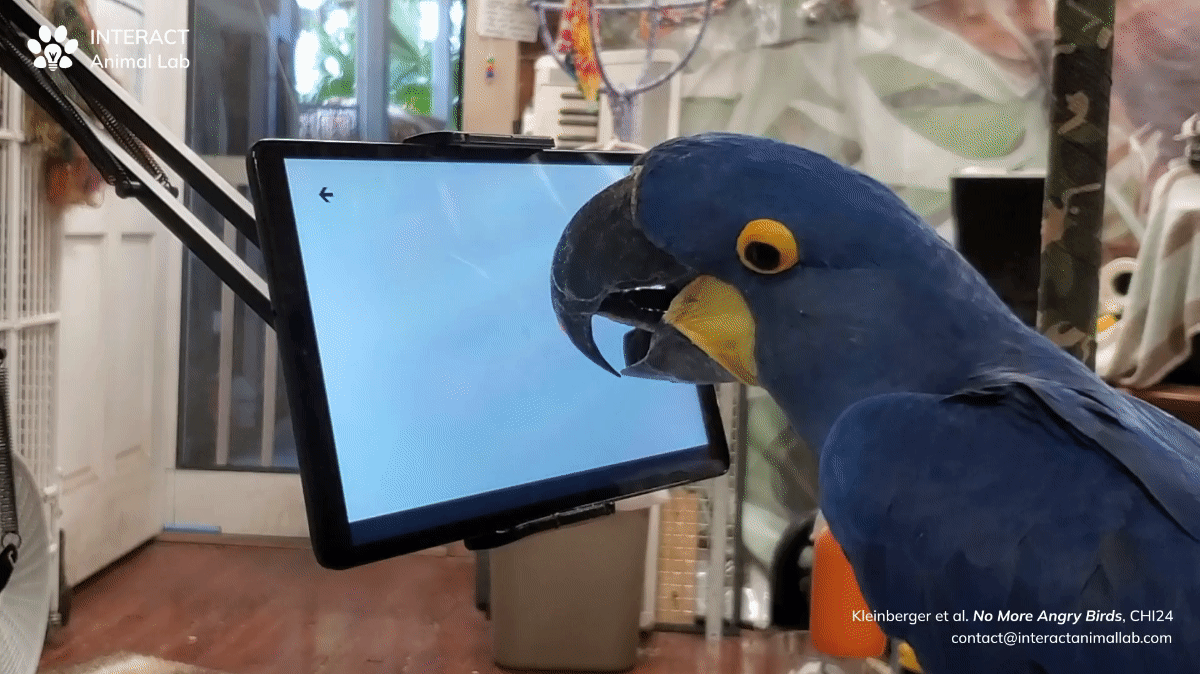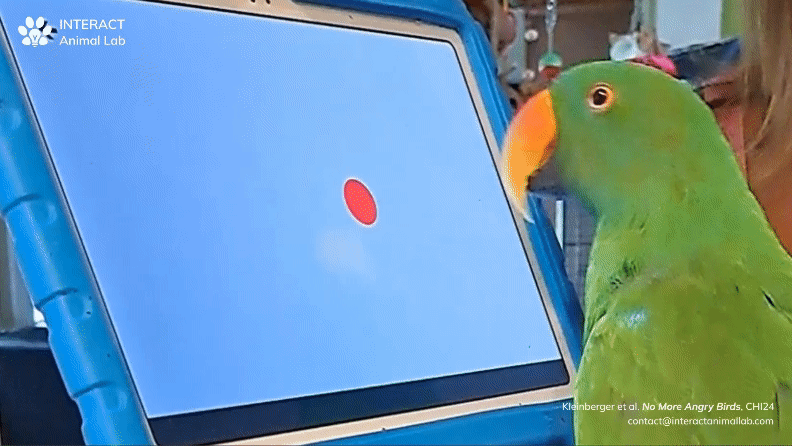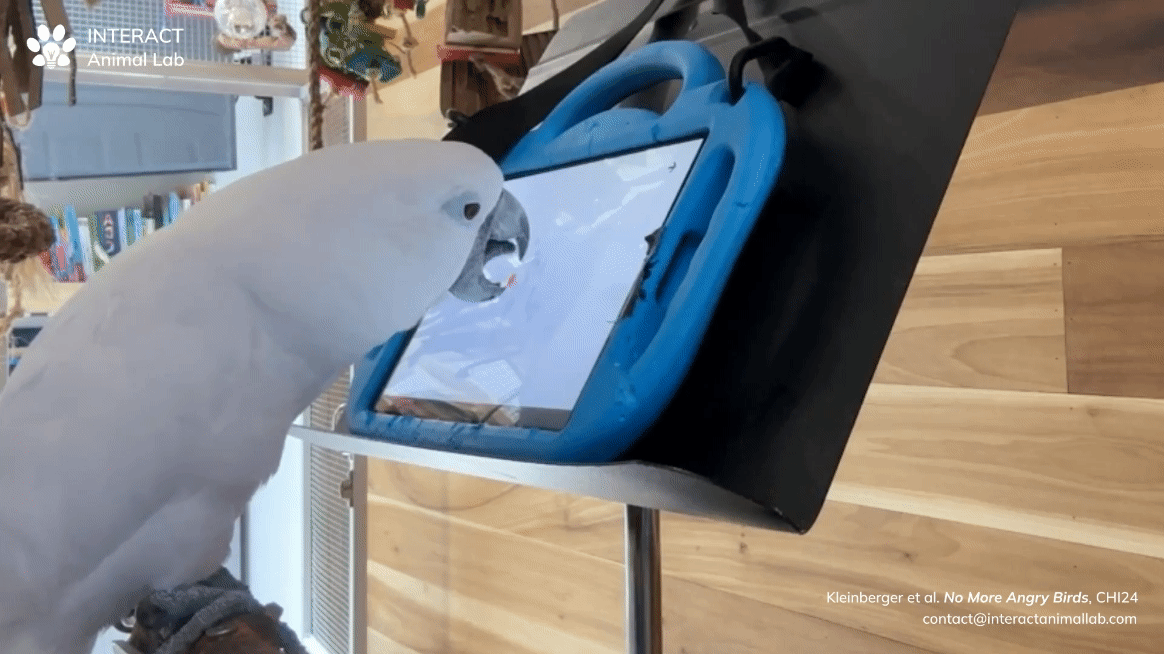Watch Pet Parrots Learn to Play Tablet Games—With Their Tongues
Scientists are studying how the intelligent, social birds interact with touchscreens to help design mobile apps that serve as enrichment for the birds

Parrots are highly intelligent, social creatures. In the wild, they spend most of their time interacting with other parrots—preening one another, foraging together and roosting in groups at night. They’re also physically active, flying long distances in search of their next meal, and when they do find food, they work hard to extract nuts from shells and juice from bark.
When kept as pets, however, this means parrots can easily become bored and lonely. Human owners do their best, but keeping the birds engaged, active and happy can be challenging.
Now, researchers say mobile games on tablets might be able to help. Scientists are gathering data on how pet parrots interact with touchscreens, in hopes that they might one day design apps specifically for the birds, they report in a new paper.
The study has not yet been peer-reviewed, but it will be presented at an academic conference next month. Last year, the same labs presented research on pet parrots engaging in video calls with other birds. Both projects were collaborations between Northeastern University’s INTERACT Animal Lab, led by Rébecca Kleinberger, and the University of Glasgow’s Animal-Computer Interaction Lab, led by Ilyena Hirskyj-Douglas.
Some pet parents already use mobile games and apps to help keep their parrots occupied. But these apps are designed for human fingers, not digit-less birds. Researchers wondered what changes they could implement to make mobile games more parrot-friendly, so they recruited 20 pet birds and their human caregivers to help them find out. The birds represented a variety of species, including macaws, grey parrots, cockatoos and parakeets.
“A lot of research on animals and technology is about trying to understand: What can animals do?” study co-author Kleinberger tells the New York Times’ Emily Anthes. “And what I always try to do is reframe the question to: What can we do for them?”
The team used a simple tablet game to gather data on how the birds interacted with the touchscreens. During gameplay, multicolored circles appeared in random places against a white background on the screen. The birds’ task was to touch the circles with their beaks and tongues.
With training and encouragement from their human owners, the birds engaged in daily gameplay sessions of less than 30 minutes each for three months, using basic tablets. All the winged participants already had some experience with touchscreens, and they played the game in the comfort of their own homes. The birds were also given an easy “escape route” so they could walk or fly away if they no longer wanted to participate, the researchers write in the paper. (Ultimately, three birds dropped out of the study after they lost interest or began to show signs of aggression.)
As the birds tried to poke the circles, the tablets gathered data, such as how much pressure they used and how far they dragged their tongues across the screen. The devices also recorded the locations of the birds’ touches, as well as how frequently and accurately they tapped the circles. The human owners also recorded videos of their birds using the app.
After synthesizing all the information, researchers gleaned some valuable insights from the tests. For starters, they learned the birds primarily used their tongues to interact with the tablet. But using their tongues also meant their eyes were very close to the screen, so the birds often pulled back their heads before tapping the next target—and the data supported this, showing a delay between touches, even when the circles got closer together. This likely contributed to the parrots being slower and less accurate than humans, though they improved when the circles were larger.
The birds also used less pressure than humans, so the game didn’t always acknowledge their taps. The birds also tended to drag their tongues across the screen in a licking motion. Some parrots used their tongues to rapidly touch the same circle multiple times, with up to 41 touches in a row.

Many of the human owners reported that their birds appeared to enjoy themselves and that playing the tablet game together was a good way for them to bond. In all, the findings suggest the project is a “good example of how studying animals’ bodies can inform the design of new interfaces to empower animals,” Kleinberger says in a statement. The research might someday lead to the development of new products and services that can help improve the lives of companion animals.
But the team emphasized that mobile apps are not meant to be a replacement for human interaction. Rather, they should be used as a supplementary tool for enhancing social time between the parrots and their owners.
“Human support and facilitation was central to our study,” they write in the paper. “Caregivers provided rewards and praise to make the experience more significant and rewarding for the birds.” Having the owner there “enriches the experience with technology while providing a safer and more nurturing environment for the animals.”

Irene Pepperberg, an animal behaviorist and psychologist at Boston University who specializes in parrots but was not involved with the new study, echoed that sentiment, telling Smithsonian magazine that human caregivers should always be present to monitor their birds whenever they play with tablets.
Pepperberg, who founded the nonprofit Alex Foundation to support parrot research, says she hopes touchscreen games won’t take the place of other types of engagement, such as exercise, natural foraging behavior and preening. Ideally, pet parents would view tablets as “additional enrichment materials.”
Even with the opportunity to play mobile games, parrots still need foraging toys and large cages where they can stretch their wings, as well as climb and perch on multiple levels, she adds.
“In principle, I’m in favor [of apps designed for parrots], given that these birds are often locked in cages—often without any other companions—for eight to ten hours a day while their owners are at work, commuting and engaging other activities that remove them from the house,” Pepperberg says. “Computer interfaces could provide additional forms of stimulation.”
/https://tf-cmsv2-smithsonianmag-media.s3.amazonaws.com/accounts/headshot/SarahKuta.png)


/https://tf-cmsv2-smithsonianmag-media.s3.amazonaws.com/accounts/headshot/SarahKuta.png)